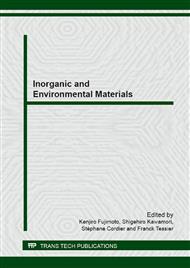p.3
p.10
p.14
p.18
p.24
p.28
p.32
p.36
An Innovative Low Density Synthetic Carbonate with a Composite Structure
Abstract:
A new low density mineral material has been synthesized via a simple, flexible, cheap and easy to control process. This material is a synthetic carbonate produced by carbonation of a solid phase composed of a calcic part and a magnesian part. Typically, its production process includes the calcination of a raw dolomite (general formula CaCO3.MgCO3) into the oxide form, followed by an at least partial hydration of this oxide and a subsequent carbonation step. This process is thus close to the well-known process used for the production of Precipitated Calcium Carbonate (PCC), a common filler and pigment in plastic, paper and rubber, except that the raw material is a dolomite instead of a limestone. It has to be pointed out that flue gases from different industries can be used as a source of CO2 for the carbonation. Many parameters have been studied, such as the hydration conditions or the carbonation conditions, allowing the production of a whole range of products. The products obtained via this process are composed of a calcic part, mainly as calcite and aragonite (CaCO3), and a magnesium containing part, mainly as hydromagnesite (4MgCO3.Mg (OH)2.4H2O). Compared to standard PCC, this material has a particularly low density (100-250 kg/m3 instead of 300-600 kg/m3 for standard PCC), a rather high BET specific surface area (15-35 m2/g instead of 4-15 m2/g for standard PCC) and a specific particle morphology and structure. The particles are indeed commonly spherical particles composed of a core of calcite/aragonite covered by a layer of hydromagnesite. This structure can be described as a core-shell structure. Due to these special features, this product could be used in multiple applications, such as raw material for the manufacture of insulation material, flame retardant, filler in plastics, paints, paper, rubber, and many more.
Info:
Periodical:
Pages:
3-9
Citation:
Online since:
June 2014
Authors:
Keywords:
Price:
Сopyright:
© 2014 Trans Tech Publications Ltd. All Rights Reserved
Share:
Citation:


